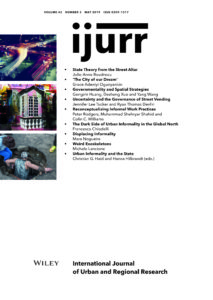This article identifies traces of the state in three urban neighborhoods of Mexico City. Instead of asking what is the state, where is it located or what does it do, the question posed here is: what are the effects of state practices at the street level? By ethnographically and visually describing how protection is performed, the article argues that the state is not only ‘somewhere’ in specific functions, actors or institutions; it also manifests materialized effects produced by a web of conflict‐ridden relations. Discussion about the state in the global South generally revolves around its failures and informality. The proposal here is that, by analyzing the state from the standpoint of urban space, the focus is on how protection is performed and by means of which operations, relations, objects and actors—not whether the state works or not, or whether actors are formal or informal. Based on ongoing ethnographic work and a collaboration with two visual artists in Mexico City, the article analyzes three protective processes: the ‘muscles’ (involving actors including police officers, gang leaders, fathers and husbands), the ‘saint’ (involving caring for representations of various saints and participation in other clientelistic chains of fidelity) and the ‘amparo’ (a form of application of the rule of law in a personalized manner for the redress of interpersonal conflicts). These are three sets of practices that have been embedded in Mexico’s history of state formation since the days of colonization.
Details
Written by:
Julie‐Anne Boudreau
Digital Object Identifier (DOI)
10.1111/1468-2427.12694
About DOI

